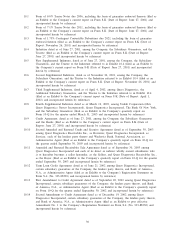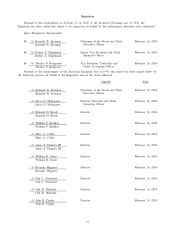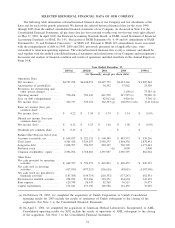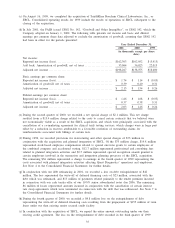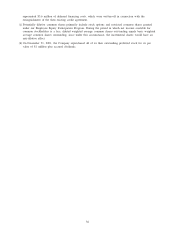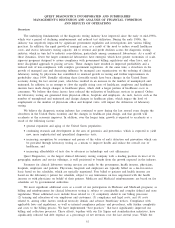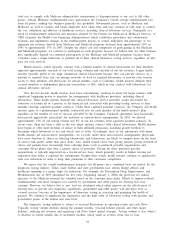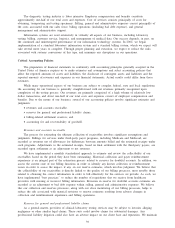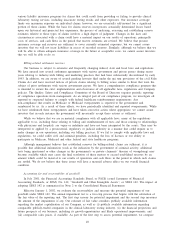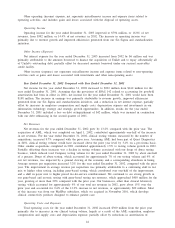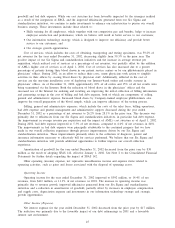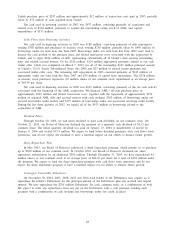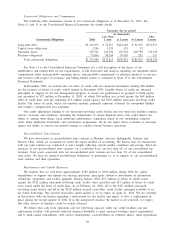Quest Diagnostics 2003 Annual Report Download - page 57
Download and view the complete annual report
Please find page 57 of the 2003 Quest Diagnostics annual report below. You can navigate through the pages in the report by either clicking on the pages listed below, or by using the keyword search tool below to find specific information within the annual report.various liability insurance programs for claims that could result from providing or failing to provide clinical
laboratory testing services, including inaccurate testing results and other exposures. Our insurance coverage
limits our maximum exposure on individual claims; however, we are essentially self-insured for a significant
portion of these claims. While the basis for claims reserves incorporates actuarially determined losses based
upon our historical and projected loss experience, the process of analyzing, assessing and establishing reserve
estimates relative to these types of claims involves a high degree of judgment. Changes in the facts and
circumstances associated with a claim could have a material impact on our results of operations, principally
costs of services, and cash flows in the period that reserve estimates are revised. We believe that present
insurance coverage and reserves are sufficient to cover currently estimated exposures, but we cannot assure
investors that we will not incur liabilities in excess of recorded reserves. Similarly, although we believe that we
will be able to obtain adequate insurance coverage in the future at acceptable costs, we cannot assure investors
that we will be able to do so.
Billing-related settlement reserves
Our business is subject to extensive and frequently changing federal, state and local laws and regulations.
We have entered into several settlement agreements with various government and private payers during recent
years relating to industry-wide billing and marketing practices that had been substantially discontinued by early
1993. In addition, we are aware of several pending lawsuits filed under the qui tam provisions of the civil False
Claims Act and have received notices of private claims relating to billing issues similar to those that were the
subject of prior settlements with various government payers. We have a comprehensive compliance program that
is intended to ensure the strict implementation and observance of all applicable laws, regulations and Company
policies. The Quality, Safety and Compliance Committee of the Board of Directors requires periodic reporting
of compliance operations from management. As an integral part of our compliance program, we investigate all
reported or suspected failures to comply with federal healthcare reimbursement requirements. Any
non-compliance that results in Medicare or Medicaid overpayments is reported to the government and
reimbursed by us. As a result of these efforts, we have periodically identified and reported overpayments. While
we have reimbursed these overpayments and have taken corrective action where appropriate, we cannot assure
investors that in each instance the government will necessarily accept these actions as sufficient.
While we believe that we are in material compliance with all applicable laws, many of the regulations
applicable to us, including those relating to billing and reimbursement of tests and those relating to relationships
with physicians and hospitals, are vague or indefinite and have not been interpreted by the courts. They may be
interpreted or applied by a prosecutorial, regulatory or judicial authority in a manner that could require us to
make changes in our operations, including our billing practices. If we fail to comply with applicable laws and
regulations, we could suffer civil and criminal penalties, including the loss of licenses or our ability to
participate in Medicare, Medicaid and other federal and state healthcare programs.
Although management believes that established reserves for billing-related claims are sufficient, it is
possible that additional information (such as the indication by the government of criminal activity, additional
tests being questioned or other changes in the government’s or private claimants’ theories of wrongdoing) may
become available which may cause the final resolution of these matters to exceed established reserves by an
amount which could be material to our results of operations and cash flows in the period in which such claims
are settled. We do not believe that these issues will have a material adverse effect on our overall financial
condition.
Accounting for and recoverability of goodwill
In July 2001, the Financial Accounting Standards Board, or FASB, issued Statement of Financial
Accounting Standards, or SFAS, No. 142, “Goodwill and Other Intangible Assets’’, or SFAS 142. The impact of
adopting SFAS 142 is summarized in Note 2 to the Consolidated Financial Statements.
Effective January 1, 2002, we evaluate the recoverability and measure the potential impairment of our
goodwill under SFAS 142. The annual impairment test is a two-step process that begins with the estimation of
the fair value of the reporting unit. The first step screens for potential impairment and the second step measures
the amount of the impairment, if any. Our estimate of fair value considers publicly available information
regarding the market capitalization of our Company, as well as (i) publicly available information regarding
comparable publicly-traded companies in the clinical laboratory testing industry, (ii) the financial projections and
future prospects of our business, including its growth opportunities and likely operational improvements, and
(iii) comparable sales prices, if available. As part of the first step to assess potential impairment, we compare
40


